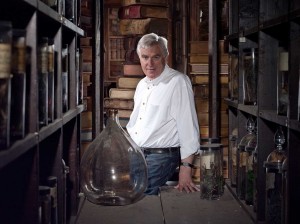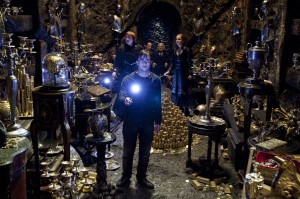
It’s been more than a decade since Harry Potter and the Sorcerer’s Stone debuted and now production designer Stuart Craig closes the eight-volume book on the series, an “octalogy,” in fact, having designed every movie in the series including 2011’s finale, Harry Potter and the Deathly Hallows: Part II.
Craig is currently working on not just a theme park based on the movies, but an extension of the theme park – “The Wizarding World of Harry Potter,” in Orlando. Indeed, none other than the series’ author, J.K. Rowling, insisted he be brought on to design the park, trusting only him to preserve the continuity of the look that has become famous, if not beloved, among millions worldwide.
When I asked Craig where it all began, he said, “England.” Turn the clock back to what filmmaking was like 12 years ago, and to before the Potter series had earned a single dollar at the box office, and you find Craig, together with set decorator Stephenie McMillan, who has done all the films with him, scouting for locations.
“We realized very quickly the only buildings old enough were the great European cathedrals and the oldest universities, such as Cambridge and Oxford,” he says. “That set the architecture and the scale of it, everything was oversized.
“As it went on, we were able to build our world more and more, and on the final films we very rarely went on location, but the style was set. It was great to go on feeding from that original source material and working with endless variations on that theme – but it all went back to those original spaces,” he says.
“Then when the magic happened, the fact that it grew out of something so real and so credible made it all the more powerful,” he says.
The series has gone on so long that the technology of filmmaking has influenced the way Craig has operated and, indeed, in Deathly Hallows: Part II, he used some techniques for the first time.

“Each time Hogwarts (the school for wizards) appeared in the previous films, we used a miniature,” he says. “But this time, the special effects team felt the time had come to create it digitally. Because of my age and the era in which I was trained and brought up,” he says, “I was a little doubtful.” Craig will turn 70 in April and when asked about his design process, says, “I still use a pencil. A wooden pencil.”
“I felt the details would let us down. But it was untrue. The reverse was the case.” Going digital “allowed us to go in very close, much closer than the physical model had. The textures were totally convincing. It was a great lesson for me and a great step forward for the movie.”
That said, one of the greatest thrills connected with the moviemaking experience, he says, is blending the new technology with the old. “You see vast landscapes beyond the windows, and that’s paintings done in the old-fashioned, time-honored way. And in the same scene you have guys doubling the length of the physical set using digital means,” he says. “It’s a celebration of the old traditional skills and the new ones together.” Craig estimates that in many of the key scenes in the final film, 50 to 60 percent of what is on screen is an actual, physical set.
Craig has been nominated for nine Academy Awards and won three times for Gandhi (1982), Dangerous Liaisons (1988) and The English Patient (1996).
“That was a different era,” he says. “You had to go to India to make Gandhi. You had to go to Morocco to make The English Patient.” He also went to Columbia and Argentina to make The Mission, directed by Roland Joffe.
“Lawrence of Arabia, as I was coming up, was the ultimate experience in that regard. You lived the experience so you could make the film. These days, you don’t do that.”
Asked about his chances to win awards this season, Craig says, “Usually, I’ve felt someone else was going to win.” The year he won for Gandhi, E.T.: the Extraterrestrial received several nominations, he says. “At any rate, the Oscar ceremony is pretty intimidating, I must say. You enjoy it hugely when it’s past. Sitting there waiting for that decision, it concentrates the mind.
“But I think the Academy members like something serious and worthy – a drama. It can be an operatic drama, and I’ve been lucky to win with movies of that kind, The English Patient, and so on, but I think the kind of fantasy Harry Potter is, it is difficult to get enough members’ attention.
“Whether we do or whether we don’t,” he says, “we’ve had a tremendous run. It’s amazing, isn’t it?”





